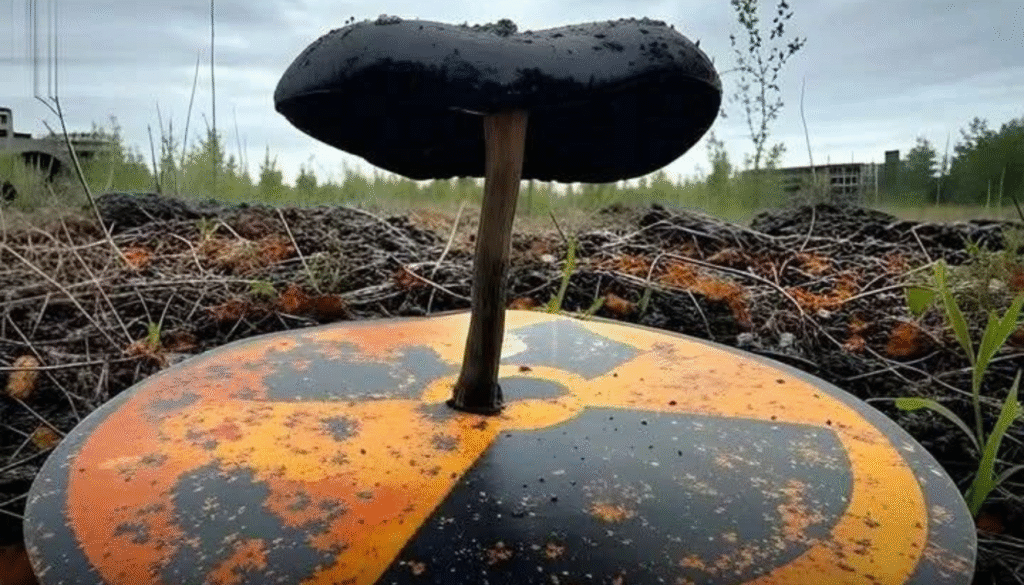In one of the most dangerous places on Earth—Chernobyl—life is not only surviving, but thriving. Deep within the radioactive remains of the infamous nuclear disaster, scientists discovered something astonishing: fungi that consume radiation.
Yes, you read that right.
Certain black fungi, such as Cladosporium sphaerospermum, have evolved a rare ability to absorb ionizing radiation and convert it into chemical energy. This extraordinary process, known as radiosynthesis, has the potential to transform radiation from a lethal threat into a source of life.
But what exactly are these fungi doing—and why does it matter for the future of space travel, medicine, and nuclear safety?
A Fungus That Feeds on Radiation?
The first clues emerged from Chernobyl’s reactor ruins, where researchers observed colonies of dark fungi growing toward the highest radiation zones—a behavior called radiotropism.
These fungi are heavily melanized, meaning their cell walls contain high concentrations of melanin, the same pigment that protects human skin from UV rays. But in these fungi, melanin does much more—it appears to act like a biological solar panel, capturing radiation and transforming it into usable energy.
This isn’t photosynthesis. This is something new.
In a 2007 study published in PLoS ONE, researchers found that when exposed to ionizing radiation, these melanized fungi not only survived—they grew faster.
This process, dubbed radiosynthesis, could represent a previously unknown form of metabolism, especially in environments where sunlight is absent, but radiation is plentiful.
Fungi in Space: Tested on the ISS
After the initial discovery in Chernobyl, the big question was: Can this work beyond Earth?
In 2020, NASA conducted experiments aboard the International Space Station (ISS), placing samples of Cladosporium sphaerospermum in low Earth orbit to observe their growth and radiation-blocking potential in space.
The results? The fungi:
- Thrived in microgravity
- Reduced radiation by up to 2% in a small test setup
- Showed potential for self-replicating, self-healing radiation shields
This might sound like science fiction, but it’s real. These space fungi could one day protect astronauts from cosmic radiation during long-term missions to Mars or deep space.
The Mechanism: How Does Radiosynthesis Work?
While research is ongoing, the working hypothesis is this:
- Ionizing radiation hits melanin in the fungal cells.
- Melanin’s electronic structure shifts, absorbing energy.
- This energy is then converted into a form the fungus can use—likely boosting its metabolic functions and growth.
It’s a process similar to how plants use chlorophyll to capture sunlight, but here, the “sunlight” is gamma radiation.
Applications Beyond Space
The potential of radiotrophic fungi doesn’t stop at space exploration. Here’s where else this discovery could be revolutionary:
🛰 Space Missions
Radiotrophic fungi could form part of living shields for spacecraft, space stations, or planetary habitats—growing around critical components or lining walls to absorb harmful radiation.
🏥 Medical Use in Radiotherapy
Because they naturally handle ionizing radiation, these fungi—or melanin-inspired biomaterials—could be adapted into protective coatings or adjunct therapies for cancer patients undergoing radiotherapy.
☢️ Nuclear Cleanup
Fungi that feed on radiation could help in nuclear disaster zones or waste storage facilities, acting as biological buffers or remediation agents.
🧪 Biotech and Material Science
Fungal melanin may inspire new kinds of radiation-proof materials—flexible, organic, and potentially self-repairing.
Nature’s Answer to a Man-Made Problem?
It’s poetic, in a way. A man-made disaster like Chernobyl gave rise to a natural discovery that could help humanity survive in extreme environments.
What if the key to colonizing Mars… or safely cleaning up radioactive waste… or protecting cancer patients… isn’t a high-tech invention, but a humble black fungus?
In the words of NASA researchers:
“The fungus not only adapted to extreme conditions but uses them to its advantage.”
Final Thoughts: Innovation Rooted in Nature
Science fiction often imagines the future with machines and metal. But the true breakthroughs may come from nature—adapted, optimized, and applied in new ways.
Fungi like Cladosporium sphaerospermum are more than survivors—they are potential allies in some of humanity’s greatest challenges.
And once again, nature proves that sometimes, the most unexpected solutions grow in the darkest places.



